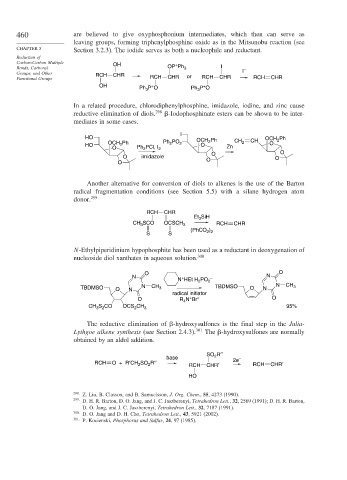Page 487 - Advanced Organic Chemistry Part B - Reactions & Synthesis
P. 487
460 are believed to give oxyphosphonium intermediates, which then can serve as
leaving groups, forming triphenylphosphine oxide as in the Mitsunobu reaction (see
CHAPTER 5 Section 3.2.3). The iodide serves as both a nucleophile and reductant.
Reduction of
Carbon-Carbon Multiple OH +
Bonds, Carbonyl OP Ph 3 I –
Groups, and Other RCH CHR I
Functional Groups RCH CHR or RCH CHR RCH CHR
OH Ph P O Ph 3 P O
+
+
3
In a related procedure, chlorodiphenylphosphine, imidazole, iodine, and zinc cause
reductive elimination of diols. 298 -Iodophosphinate esters can be shown to be inter-
mediates in some cases.
I
HO OCH Ph OCH Ph
2
OCH Ph Ph PO 2 2 CH 2 CH O
2
HO 2 O
O Ph PCl, I 2 Zn
2
O O
O imidazole O
O O
Another alternative for conversion of diols to alkenes is the use of the Barton
radical fragmentation conditions (see Section 5.5) with a silane hydrogen atom
donor. 299
RCH CHR
Et 3 SiH
SCO OCSCH
CH 3 3 RCH CHR
)
(PhCO 2 2
S S
N-Ethylpiperidinium hypophosphite has been used as a reductant in deoxygenation of
nucleoside diol xanthates in aqueous solution. 300
O O
N + – N
N HEt H PO 2
2
TBDMSO O N N CH 3 TBDMSO O N N CH 3
radical initiator
+
O R N Br – O
4
CH S CO OCS 2 CH 3 95%
3 2
The reductive elimination of -hydroxysulfones is the final step in the Julia-
Lythgoe alkene synthesis (see Section 2.4.3). 301 The -hydroxysulfones are normally
obtained by an aldol addition.
SO R′′
base 2 –
RCH O + R′CH SO R′′ RCH CHR′ 2e RCH CHR′
2
2
HO
298 Z. Liu, B. Classon, and B. Samuelsson, J. Org. Chem., 55, 4273 (1990).
299
D. H. R. Barton, D. O. Jang, and J. C. Jaszberenyi, Tetrahedron Lett., 32, 2569 (1991); D. H. R. Barton,
D. O. Jang, and J. C. Jaszberenyi, Tetrahedron Lett., 32, 7187 (1991).
300 D. O. Jang and D. H. Cho, Tetrahedron Lett., 43, 5921 (2002).
301
P. Kocienski, Phosphorus and Sulfur, 24, 97 (1985).

